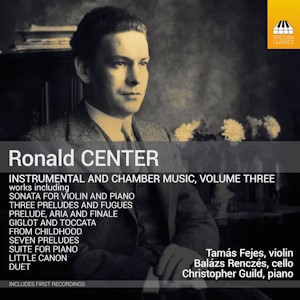
Ronald Center (1913-1973)
Instrumental and Chamber Music Volume Three
Tamás Fejes (violin), Balázs Renczés (cello), Christopher Guild (piano)
rec. 2019-2023
Toccata Classics TOCC0723 [78]
The completists among us had to wait a decade after Ronald Center’s piano music disc (review). His three string quartets appeared three years ago (TOCC 0533). Some of the fourteen works here are trifles, such as the Little Canon and the Duet for violin and cello. The miniatures From Childhood – “The Bogey-Man”, “Doll’s Waltz” and so on, with a touch of bi-tonality – may have been written for his pupils. The Giglot in Giglot and Toccata for piano is actually a Rumba.
Ronald Center seems to have been a very private man. He lived in remote Scotland and composed just as he fancied. He has been called the Scottish Bartók. That shows up in the two major works here. The Sonata for Violin and Piano is a gripping work. Christopher Guild’s excellent notes list various influences. The opening Allegro and especially the closing Allegro veloce demonstrate the much-noted Bartokian spikiness. The virtuoso piano writing adds to the general excitement. The finale is said to be a Tarantella with an ‘eastern-European character’. The Andante con espressione middle movement is described as a ‘searching pastorale’: the harmonies are never quite stable, and the violin struggles to rest and settle until the last bars. The composer is said to have been timid and shy, but this is the music of a man with much to say and a passion to say it.
Center’s unique musical language has at least two significant traits. First, he often does not bother to develop his ideas but tumbles one after the other, as in the amazing Burlesca. It is extraordinary that it all fits together. (In the earliest of his piano pieces, the seven-minute Phantasy of 1940, this attitude is what one would expect from the title; the harmony is unequivocally diatonic.) He may have realised this could be a problem, so he wrote some Preludes and Fugues to try and tighten up his technique.
The second trait is the lack of a clear key. Center never allotted keys to the Preludes and Fugues. It is only now, for publication, that a key has been selected for each work to distinguish between them. It seems that, as in the A major work, it is largely the final chord that has given the work a key centre. Contrapuntally, though, the pieces are a tour de force.
The other significant work is the three-movement Suite for Piano, as difficult to date as most of the pieces here. One might ask why it is not called a Sonata. That may be because if the rather discursive titles, such as the middle movement’s “Children at Play”. This brings us to yet another trait in Center’s language, illustrated by this terrific piece. There are drones, often rhythmically repeated (the booklet writer highlights bagpipes as the inspiration), and childlike melodies as in the central Andante.
Seven Preludes are another work here which I consider quite an attraction. Their less than ten minutes are full of variety, with jazz influences in numbers one and three, hints of Schubert and even folk melodies. There are sections which Center developed into longer works. Bartók is not that far away as well.
I have come to hold Ronald Center’s music in high regard. It is original, entertaining, varied and rhythmically complex. Christopher Guild, who has now recorded all of the piano pieces, is the best guide one could have, with his love and admiration for the man and the music.
Gary Higginson
Previous review: John France (May 2024)
Buying this recording via a link below generates revenue for MWI, which helps the site remain free


Contents
Sonata for Violin and Piano
Little Canon
Duet
Giglot and Toccata (publ.1988)
From Childhood
Burlesca
Suite for Piano
Melodie (1942)
Seven Preludes
Prelude and Fugue in E
Prelude and Fugue in G sharp
Prelude and Fugue in A
Prelude, Aria and Fugue
Recording details
2019, RSNO Concert Hall, Glasgow, UK
2021, Old Granary Studio, Toft Bank, Beccles, Suffolk, UK
2023, Wyastone Hall, Wyastone Leys, Monmouth, UK

















